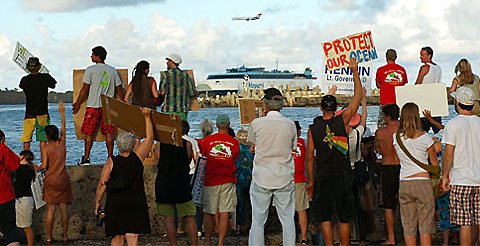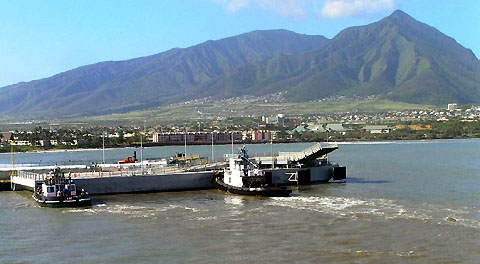www.islandbreath.org ID#0809-09
SUBJECT: SUPREFERRY NEWS
SOURCE: JUAN WILSON juanwilson@mac.com
POSTED: 1 FEBRUARY 2008 - 7:30am HST
HSF winter of discontent

image above: Protests on 8/27/07 in Nawiliwili Harbor as Superferry approached. By Dennis Fujimoto
by Laura Bly, on 31 January 2008 in USA Today When high surf and rudder cracks forced the Hawaii Superferry to scuttle trips between Oahu and Maui for the fifth day in a row this week, it was the latest wave in what has been a sea of troubles for the high-speed catamaran. With a capacity of 866 passengers and more than 200 cars and trucks, the $85 million, U.S.-built Alakai — Hawaiian for "ocean path" — was designed as a modern reincarnation of the double-hulled Polynesian canoes that once plied the Hawaiian chain. Intended to zip residents, tourists and local business owners and their wares on daily crossings from Honolulu to Maui and Kauai (a second vessel is planned for Big Island service in 2009), the Alakai was touted as a scenic, fuel-efficient alternative to inter-island flights. But the Alakai faced protesters and legal challenges long before it arrived in Hawaii last summer. Environmentalists, worried about the effect on migrating humpback whales and the potential for transporting invasive species, argued that the ferry's owners needed to file an environmental impact statement before launching service. Residents on Maui and Kauai, already anxious about a surge in tourist arrivals and new development, voiced concerns about increased traffic congestion and crowding of island parks and beaches. After several months of on-again, off-again drama — including a blockade of Kauai's Nawiliwili harbor by opponents on surfboards and outrigger canoes and intervention by the Hawaiian Legislature and governor to keep the ferry going while it completes an environmental review — the Alakai started offering one daily round trip between Honolulu and Kahului, Maui, in mid-December. Kauai service was suspended indefinitely, and a planned second daily trip to Maui was postponed when Maui's mayor complained that local officials weren't consulted. Despite computer-controlled stabilizers and other features designed to smooth the 349-foot-long Alakai's ride, rough winter seas have forced the Superferry to cancel trips 11 days in less than two months. That's far more than the 2% cancellation rate officials had planned, and roiling conditions have helped earn the vessel a nickname: "the barf barge." Meanwhile, the Alakai has attracted an average of 162 passengers a trip vs. its planned ridership of 410. It has tried to boost sales by dropping a fuel surcharge and extending a promotional rate of $39 a passenger plus tax, one way. By contrast, a half-hour flight between Honolulu and Kahului costs $55, one way. Recent Alakai passenger Janet Anderson, who was visiting last month from Forest Grove, Ore., was thrilled with her three-hour journey from Maui to Honolulu, from the shipboard puu puus (appetizers) and cushy leather sofas to mesmerizing views of Molokai's serrated coastal cliffs and friendly crewmembers who treated her "like royalty." But she was less enamored when she turned on the local news in her Waikiki hotel room, getting ready for her 6:30am. return trip to Maui, and learned the Superferry was grounded by high seas. "This was not a big inconvenience because we hadn't checked out of the hotel," says Anderson, who wound up flying back to Maui later that day. "I wish them luck getting the bugs out. … These kinds of things happen, but it would be important to know you could stick with your plans." Adds First Hawaiian Bank consultant Leroy Laney, "It's unfortunate that ridership is not living up to expectations and that (the Superferry) has been hit with cancellations." He says the new service is a welcome addition to the state's financially troubled interisland airlines, "but it doesn't auger very well for the future." Superferry fares between Honolulu and Maui's Kahului Harbor are $39 a passenger and $55 for cars, plus tax, for tickets purchased through March 31 for travel through June 5. Information: 877-443-3779 or hawaiisuperferry.com. |
SUBJECT: SUPREFERRY NEWS
SOURCE: JUAN WILSON juanwilson@mac.com
POSTED: 24 JANUARY 2008 - 8:30am HST
Bits and pieces about HSF

image above: tugs adjusting Superferry barge ramp in Kahului Harbor at $5,000 a day cost
[Editor's Note: The story below is sad but true. The State of Hawaii, and its taxpayers, will be shelling out a fortune in tug services to keep the Superferry barge next to the pier so the ship can use Kahului Harbor on Maui. Wasn't this need anticipated? What kind of business plan was put together to cnvince our state to partner up with these bozos at a cost of over $40 million dollars. That does not even count the hundreds of millions being sought for statewide harbor improvments now being studied. The traffic count being conducted by Brad Parsons and others on Maui indicate that the ferry is running at average about 25-30% of break-even passenger capacity. Kahului Traffic count for 23 January 2008
|
| [Editor's Note: The stories below about the Kauai Chamber of Commerce supporting the Superferry is truely a stale rehash. It's hard to believe this junk made the top fold of the Garden Island News as a headline. The Kauai Chamber of Commerce has been behind the HSF service since day one. It looks like the the Superferry Corporation PR flacks must be trying to find a way to lose money by returning to Kauai. They certainly realize that a second trip to Maui is unfeasable now. The second trip would require sailing at night in winter. Earlt sunsets, high seas, whitecaps will make the second trip much more likely to hit whales off Molokai. Without picturesque views of Molokai this will be much less attrative a trip to to potential customers.]
|
[Editor's Note: The Superferry Corporation has become a "textbook" case of bad business practice in Hawaii. The paying customers are a fraction of what is needed to support this business operation, and that is during the $39 special introductory price schedule.]
[Editor's Note: At some point in the future we remind Professor Kelleher and re-emphasize the point that "Public Relations" is much more than simply a messaging system by which a company "manages" the public to leave them alone and let them do what they want. Public Relations deals more broadly with how a business literally relates to the public.
|
see also:
Island Breath: HSF night trips 1/11/08
Island Breath: HSF militiary trips 1/8/08
Island Breath: HSF EIS Smoking Gun 1/6/08
Island Breath: HSF two trips 1/5/08
Island Breath: Maui Demostrations 12/16/07
Island Breath: Maui Service Begins 12/14/07
Island Breath: Maui Service Postponed 12/5/07
Island Breath: Maui Planning Demo 11/27/07
Island Breath: Ti Party a big success 11/6/07
Island Breath: Ti Party to be held 11/3/07
Island Breath: Banana Republic 11/2/07
Island Breath: One more HSF Hurdle 11/1/07
Island Breath: Legislature OKs Superferry 10/31/07
Island Breath: Special Session on HSF 10/25/07
Island Breath: Conditions for Special Session 10/18/07
Island Breath: News of September 25-26 9/25/07